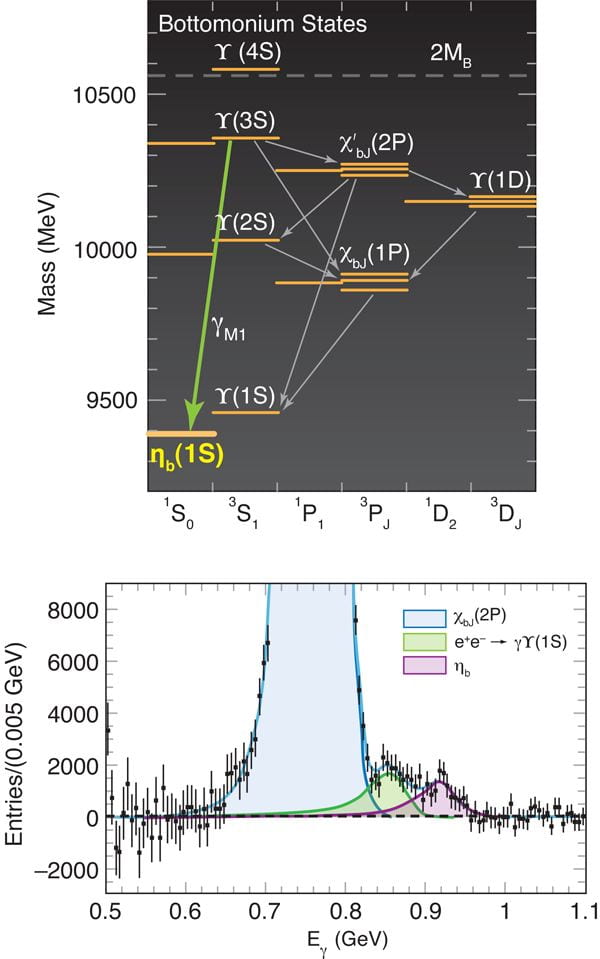The bottom quark is the second-heaviest known quark. It is a “down-type” quark, meaning that it has an electric charge that is negative and one-third that of the elementary charge of the electron (-1/3e). It is a Fermion, meaning it has half-integer internal spin angular momentum; in this case, like all other quarks, it is spin-1/2.
It was discovered in 1977 by the E288 experiment at Fermi National Accelerator Laboratory. Its existence was not a complete surprise, since it had been described earlier by the physicists, Makoto Kobayashi and Toshihide Maskawa, who expanded the theoretical ideas of Nicola Cabibbo as regards the mixing of different quark flavors 1.
The bottom quark is part of the third generation of matter. Its existence is actually required, theoretically, if one wants to use the electroweak force to explain the origin of the violation of Charge-Parity Symmetry violation in nature. CP violation was discovered much earlier, in the late 1950s, and one way to explain its existence was if there were at least three generations of quarks. Bottom and its “up-type” partner, the top quark, define this generation. Their existence then necessitates the use of a certain kind of mathematical object that naturally allows for the violation of CP symmetry in nature.
The bottom quark was discovered in bound-state configurations, specifically in the form of the Upsilon meson. An Upsilon meson is a bound pair of a bottom and an antimatter bottom quark. This class of matter is generally called “bottomonium.” It has a net spin angular momentum of 1 (you can think of the two quarks inside the Upsilons as having their individual spin angular momenta aligned in the same direction). When it decays, it does so often to a pair of muons. This allowed it to be detected, and makes for a powerful and clean means of observing this kind of state of matter.

However, the Upsilon is not the lowest-energy configuration of the two bottom quarks. Instead, the configuration where their spins can point in opposite directions yields the lowest energy, or “ground state,” configuration of the quarks. This went undiscovered for almost 30 years after the bottom quark was first identified, mainly due to the fact that it is far more challenging to detect in a collider-detector experiment. I helped lead the effort, using the PEP-II collider and the BaBar Detector, that resulted in the discovery of the ground state, called the “eta-b” particle. This was first observed in 2008.

Read about the discovery of the eta-b:
Observation of the Bottomonium Ground State in the Decay Υ(3S)→γηb
B. Aubert et al. (BABAR Collaboration)
Phys. Rev. Lett. 101, 071801 (2008)
Published August 11, 2008
Bottom quarks play a significant role in the study of the Higgs particle. The Higgs has a large coupling strength with the bottom quark, which is what results in it being so heavy. This also means bottom quarks play large roles in producing Higgs particles and in their subsequent decay. In fact, 59% of the time a Higgs particle will decay to a bottom and an anti-bottom quark.
The first direct observation of the Higgs decaying to bottom quarks was in 2018 and announced by the ATLAS Experiment. I am pleased to have also participated in this important discovery.
My current work on the ATLAS Experiment is focused on improving software algorithms that help to collect proton-proton collision data in real time. A number of these select collisions where bottom quarks are present. High efficiency and low background in the selection of such events will be essential to future Higgs particle physics studies.
In addition, I am developing contributions to the study of two-Higgs production using bottom quarks to identify Higgs particle decay in these events. While a messy way of looking for this process, it’s also the most prevalent decay of the Higgs particle and an important part of an inclusive strategy for discovering di-Higgs production.
In the future, I hope to study the role of the bottom quark in the structure of more familiar matter like the proton. The Electron-Ion Collider at Brookhaven should allow an unprecedented ability to tease out the rare, but non-negligible, role of this quark to the structure of the most common charged nucleon in the universe.
- “Flavor” refers to the kind of quark. Quarks come in six flavors: up, down, charm, strange, top, and bottom. The electroweak force permits the changing of one quark flavor into another, a process called “mixing.” ↩